Ford Festiva
| Ford Festiva | |
|---|---|
_Trio_3-door_hatchback_(2010-07-19).jpg) | |
| Overview | |
| Manufacturer |
Kia Mazda |
| Production | 1986–2002 |
| Body and chassis | |
| Class | Subcompact |
| Layout | Front-engine, front-wheel drive |
The Ford Festiva is a subcompact car that was marketed by the Ford between 1986 and 2002. Festiva was sold in Japan, the Americas, and Australasia. The name "Festiva" is derived from the Spanish word for "festive". It was not related to the similarly sized and named Ford Fiesta.
Designed by Mazda using the DA platform and B series inline-four engines, the Festiva continued the trend of Fords built and designed by Mazda for the Asia-Pacific market such as the Laser and Telstar.
South Korean first generation sales began in 1987 under the name Kia Pride, assembled by Kia under license. Australasia and Europe received the first version between 1987 and 1991 as the "Mazda 121". After 1991, Australasian sales occurred under the "Ford Festiva" name, while European sales continued under the name "Kia Pride". Kia ended production of the Pride in 2000, although SAIPA of Iran has produced this model in various forms since 2001. This ongoing production has been in parallel to the second generation Festiva introduced in 1993, sold as the Ford Aspire in North America and Kia Avella in South Korea and other markets. Although these second generations models were withdrawn in 2000, a third generation was sold between 1996 and 2002 in Japan as a badge-engineered version of the Mazda Demio.
First generation (WA; 1986–1993)
| First generation | |
|---|---|
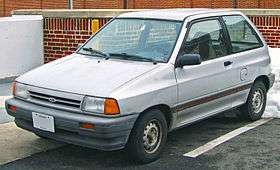 | |
| Overview | |
| Manufacturer |
Mazda (1986–1990) Kia (1986–2000) Arab American Vehicles (1998–2002) SAIPA (2001–present) |
| Also called |
Kia Pride Mazda 121 SAIPA 111/131/132/141 SAIPA 151 (pick-up) SAIPA Nasim SAIPA Saba SAIPA Turpial |
| Production |
1986–1993 1993–present (ongoing) |
| Assembly |
Japan: (Mazda) South Korea: Sohari Plant, Gwangmyeong (Kia); Gwangju Plant, Gwangju (Kia) China: Jiangsu (Dongfeng Yueda) Egypt: Cairo (AAV)[1] Iran: Tehran (SAIPA)[2] Iraq: Iskandariya (SAIPA)[3] Taiwan: (Ford Lio Ho)[4] Venezuela: Valencia (Ford Motor de Venezuela) |
| Body and chassis | |
| Body style |
2-door pickup (SAIPA) 3-door hatchback 4-door sedan 5-door hatchback 5-door liftback (SAIPA) 5-door wagon |
| Platform | Mazda DA platform |
| Powertrain | |
| Engine |
1,138 cc Mazda B1 I4 1,290 cc Mazda BJ I4[5] 1,324 cc Mazda B3 I4 |
| Transmission |
3-speed Mazda F3A automatic 4-speed manual 5-speed manual |
The first generation Ford Festiva was designed by Mazda in Japan at the request of parent company Ford.[6][7] The Mazda-designed and built three-door hatchback was launched in Japan in 1986 under the name "Ford Festiva".[8][9] Festiva utilized the front-wheel drive layout, and its mechanicals consisted of rack and pinion steering, independent front suspension with struts, coil springs and sway bar, and a torsion beam rear suspension.[6][10] The Festiva was facelifted in 1989, receiving a redesigned grille insert and tail lamp lenses.[11] In Japan at launch, the Festiva three-door was offered in L, L Special, S, Ghia, and Canvas Top specification levels.[12] Ford retailed the Japanese market Festiva via the Autorama dealership network.[12]
.jpg)

In mid-1986, another Ford partner, Kia Motors in South Korea began production of the Festiva under license as the "Kia Pride".[8] Starting from mid-1987 for the 1988 model year, Kia began exports to Canada under the "Ford Festiva" name, with United States sales commencing by the end of 1987.[12] Ford offered a single 1.3-liter B3 four-cylinder engine and three trim levels: L, L Plus, and LX.[11] The two base models featured a four-speed manual overdrive transmission, with the LX upgraded to a five-speed unit. A tachometer and tilt steering wheel also featured on the LX trim,[13] as did alloy wheels, remote mirrors, cloth interior seating, and an AM/FM cassette radio.[14] Ford released a minor facelift in North America for the 1990 model year.[15] At the same time, the engine's fuel delivery system transitioned from carburetor to fuel injection, and transmission choices were revised with a standard five-speed manual transmission and optional three-speed automatic.[11] Ford also replaced the manual front seat belts with motorized versions, and fitted manual rear seat belts as standard.[11] For the 1991 model year, the L Plus and LX models were combined into a single GL trim.[11] Optional power steering was deleted for 1992, and the GL gained alloy wheels and the availability of a "sport" package.[11] The final 1993 model year brought no changes.[11] Over the life of the Festiva in the United States, Kia exported roughly 350,000 units.[16] The agreement with Ford materialized in accordance with Kia's strategy implemented in the mid-1980s to progressively fill the void at the low-cost end of the market slowly being abdicated by the Japanese brands pursuing more expensive models with higher profit margins.[16] Compared to rival automakers in Japan, and also Europe and North America, Kia's main competitive advantage was its lower-paid South Korean workforce—which translated into lower-priced cars.[16]
Mazda began producing the Festiva as the "Mazda 121" for Australia and Europe in 1987, but this model was never retailed in Japan.[8] The 121 ended production in 1990,[17] and was officially discontinued by Mazda Australia in February 1991.[18] From October 1991, Ford Australia began importing the car as the "Ford Festiva" from Kia's South Korean production facility.[19] Where the Mazda was sold as a three-door hatchback, the Ford was sold initially as a five-door only. From January 1993, a Festiva three-door, badged "Festiva Trio" was launched in Australia.[20] Both versions were powered by the overhead camshaft carbureted 1.3-liter B3 engine with the five-speed manual transmission; a three-speed automatic was optional for the five-door.[10][21] Standard equipment in Australia included an AM/FM radio, tachometer, intermittent windscreen wipers, remote releases for the rear door and fuel tank filler door, with air-conditioning available as an option.[10] Ford discontinued the Festiva in the Australian market in March 1994.[19]
Ford Australia's action was paralleled in Europe where Kia started exporting three- and five-door hatchback, four-door sedan, and five-door wagon variants of the Kia Pride in 1991 under their own name.[22] These additional sedan and five-door hatchback body variants were also imported from South Korea to Japan in left-hand drive form (Japan officially being a right-hand drive market) as the "Ford Festiva 5" and "Festiva β", respectively.
The 2008 edition of Monash University's Used Car Safety Ratings (UCSR), found that the first generation Festiva provides a "worse than average" (two out of five stars) level of safety in the event of an accident, in a comparison to other "light cars".[23] The safety rating was not calculated solely on the basis of the protection of the vehicle's occupants, with protection for "cyclists, pedestrians and drivers of other vehicles" included to give a "better guide to the total community impact of vehicle safety."[23]
Mazda 121 (DA)
Mazda began selling the 121 as a single three-door hatchback body variant in 1987 to sit below the larger 323 model.[6] Despite being manufactured there, the 121 was not sold in Japan under the "Mazda" brand.[8] Australian specification 121s were fitted with the 1.3-liter B3 engine, mated to a five-speed manual transmission.[18] European markets also received the 55 PS (40 kW) 1.1-liter B1 engine with a four-speed manual transmission.[24]
The 121 was sold in Australia from March 1987.[6] It featured a sliding rear bench seat, which increased cargo space by as much as 180 millimeters (7.1 in).[6] Levels of trim in Australia comprised the base-line Deluxe, the Super Deluxe, and the Fun Top (based on the Super Deluxe), featuring a large electric sliding canvas sunroof.[6] From October 1988, the Super Deluxe was discontinued and replaced by the Shades trim.[6] The European premiere for the 121 was at the Geneva Auto Salon in March 1988. The 1.1-liter version was added in July 1989. Trim levels were L and LX, with an SR version also available in the UK.[24]
Mazda issued an update for the 121 (released in October 1989 for the Australian market) with a new grille insert, body-hued exterior trim, redesigned instrumentation and interior seats and trim.[18] The Mazda variant was discontinued in 1991, being replaced by a new generation Mazda 121, based on the Japanese market Autozam Revue.[18][25][26]
-
_Shades_3-door_hatchback_03.jpg)
Pre-facelift Mazda 121 Shades (Australia)
-
_Fun_Top_3-door_hatchback_(2012-01-15).jpg)
Pre-facelift Mazda 121 Fun Top, with canvas roof (Australia)
-
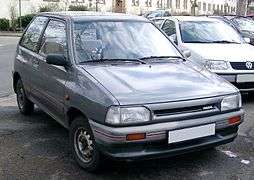
Facelift Mazda 121 (Germany)
Kia Pride (Y)
The Kia Pride badged version of the Festiva was manufactured in South Korea by Kia Motors from March 1987 to January 2000. Prior to its South Korean market release, exports as the Festiva had begun in December 1986 to Japan and the United States. The Pride was sold in four-door sedan form (in LX, GTX, and β trim levels), as well as three- and five-door hatchback forms (the CD-5) and five-door wagon body styles. Until the Mazda 121 was replaced in late 1990, Kia-badged cars were only exported to certain tertiary markets. The Pride was replaced in 2000 by the Rio.
The Pride launched in the United Kingdom in June 1991, fitted with both the 1.1- B1 and 1.3-liter B3 engines. The 1.1 was only available as a three-door in the basic L trim (whitewall tyres were a commonplace feature on them).[27] There was also a panel van two-seater version in the UK and some other markets. Fuel injection appeared on the 1.3-liter-engined models in November 1994, referred to as the "1.3i". At this time, the 1.1-liter version was deleted.[27] December 1995 saw the Start 1.3i three-door replace the L, but from June 1999, the entry-level three-door was again renamed S with the higher-level three- and five-doors known as the SX.[27] Production ended during 2000.[27]
-

Pre-facelift Kia Pride 5-door (UK)
-

Facelift Kia Pride 3-door (Germany)
-
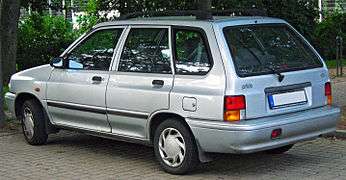
Facelift Kia Pride wagon (Germany)
SAIPA
SAIPA built the Kia Pride in Iran under license using up to 85 percent local parts as the "SAIPA Pride" from 2001 to 2005. Since 2003, a new five-door liftback model based on the Pride called the "SAIPA 141" has been produced, while continuing to sell the Iranian version of the Pride under the names "SAIPA Saba GLXi" (four-door sedan), "SAIPA Nasim Safari" (five-door wagon) and "SAIPA Nasim DMi" (five-door hatchback). Compared to the these versions, the SAIPA 141 features revised rear styling with a longer liftback tail, and different interior design. The SAIPA 141 is sold in Venezuela under name "Turpial".[28] Another variant, known as the "SAIPA 132" began production in 2008 and differs from the Saba with its revised front and rear styling. Although never mass-produced, the company introduced a pickup body style in 2008 under the name "SAIPA Pick-Up", with a 500-kilogram (1,100 lb) payload. The platform/engine of the Kia Pride also formed the basis for the Iranian P.K (2000 to 2005) and New P.K (2005 to 2007) models, which utilize Renault 5 bodies. In Iran, Prides continue to be the most common car with approximately 40 percent on vehicles in that country being a Pride-derived SAIPA.
Arab American Vehicles (AAV) manufactured the Pride in Cairo, Egypt, circa 1998.[1] Jiangsu Yueda Auto Works (later Yueda Kia Motors, currently Dongfeng Yueda Kia Motors) began assembly of the Pride in 1997. The sedan was called the Yueda Kia Pride YQZ6390, the hatchback either YQZ6370 or YQZ7141. Chinese production ended in December 2003.[29]
-
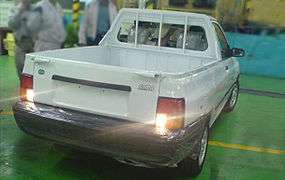
Saipa Pick-Up (Iran)
-

Saipa Pride sedan (Iran)
Second generation (WB, WD, WF; 1993–2000)
| Second generation | |
|---|---|
_GLi_5-door_hatchback_(2011-03-10).jpg) | |
| Overview | |
| Manufacturer | Kia |
| Also called |
Ford Aspire Kia Avella |
| Production | 1993–2000 |
| Assembly | South Korea: Gwangmyeong (Sohari Plant) |
| Body and chassis | |
| Body style |
3-door hatchback 4-door sedan 5-door hatchback |
| Powertrain | |
| Engine |
1.3 L Mazda B3 I4 1.5 L Mazda B5 I4 |
| Transmission |
3-speed Mazda F3A automatic 5-speed manual |
The second model Ford Festiva was jointly developed between Kia and Ford, retaining most of the drivetrain of the previous model with a more rounded body style. This new Festiva was slightly longer, wider, more aerodynamic, and suspended by MacPherson struts in the front and a torsion bar axle in the rear. While it was sold in certain markets as a second generation Festiva, Ford renamed it the "Aspire" in North American markets, where the five-door model was offered for the first time. In South Korea, the car was badged "Kia Avella". The sedan version was mainly restricted to the South Korean market, although it was also available with Festiva badging in Taiwan.
Depending on the market, some retained the SOHC, throttle-body injected motor, while others received an engine with a DOHC cylinder head and MPI also designed by Mazda. These engines were:
- B3 EGi: 1.3 L (1,323 cc) fuel injected 8-valve I4 making 63 hp (47 kW) at 5000 rpm and 74 lb·ft (100 N·m) at 3000 rpm
- B5 EGi: 1.5 L (1,498 cc) fuel injected 8-valve I4 making 88.4 hp (66 kW) at 5000 rpm and 99 lb·ft (134 N·m) at 4000 rpm (Asia and Oceania only)
Transmission options comprised a five-speed manual transmission, although all models could be optioned with a four-speed automatic. Australian and U.S. models were equipped with a three-speed automatic.
_Trio_S_3-door_hatchback_(2010-07-21)_01.jpg)
In 1997, the Festiva received a new front bumper with an oval grille, reshaped headlamps, and other minor changes. The Aspire was dropped from the Ford range in the United States after 1997.
The second generation Festiva continued to be sold in Australia until 2000 when it was replaced by the Ford Ka. Australian second-generation Festivas have U.S. side marker light cut-outs on each side of the vehicle (driver-side and passenger-side) at the front and rear. Instead of housing orange reflectors/lights at the front sides and red reflectors/lights at the rear sides, there are non-lit orange reflectors at all four locations. These redundant reflectors, coupled with the orange side indicator repeater (which is not required in the U.S., and was not included on the Aspire) make for a unique side profile.
Kia developed their following model, the Kia Rio, completely independently, and finished their relationship with Ford.
Like the first generation, the 2008 edition of the Used Car Safety Ratings (UCSR) by Monash University in Australia found the second series Festiva to provide a "worse than average" (two out of five stars) safety protection level in the event of an accident.[23] In the 2010 edition, the scoring was downgraded to "very poor" (equivalent to one of five stars, or the "significantly worse than average" terminology used in 2008).[30]
-
Pre-facelift Ford Festiva SX 3-door (Japan)
-
_GLi_5-door_hatchback_01.jpg)
Pre-facelift Ford Festiva GLi 5-door (Australia)
-
.jpg)
Facelift Ford Festiva GLi 5-door rear (New Zealand)
-

Facelift Ford Festiva sedan (Taiwan)
Ford Aspire


The Ford Aspire was sold in North America from 1994 to 1997. It was the replacement for the Ford Festiva. It was the first car in its class to have dual airbags standard and antilock brakes optional. It came in two and four door body styles, both hatchbacks. The two door was available in base and SE trim while the four door was only available in base trim. The SE model offered a sporting package that consisted of fog lights, rear spoiler, alloy wheels, blue face instrument cluster with tachometer, and upgraded interior trim. The Aspire had very few options for the base model: cassette player, automatic transmission, rear defrost and wiper, alloy wheels, and a comfort and convenience package that had several minor interior upgrades. Due to slow sales the SE model was dropped after 1995 along with all of its optional equipment. The base model also lost its optional alloy wheels and rear wiper, making the Aspire a true "stripper" of a car. The performance with the 5-speed was acceptable but the automatic was slower with 0–60 times at 16.2 seconds. Power steering was only available with the 5-door automatic. The Aspire was given a facelift in 1997 with redesigned front and rear bumpers, a new radio, and new seat facings. In August 1997, Ford announced the Aspire would be discontinued due to slow sales. The last one rolled off the assembly line on September 26, 1997.
Kia Avella
The version of the Festiva sold in Korea, from March 1994, was badged "Kia Avella".[31][32] "Avella" was a made up portmanteau word, combining aveo (Latin for "desire") and ella (Spanish for "she").[33] Available in sedan (Avella Delta), three-door and five-door hatchback body styles. Sales of the Avella totalled 115,576 in 1994 but dropped to only 27,850 in 1998. The Avella was primarily intended for export markets carrying Ford badging, as South Korean customers tended to prefer sedans over hatchbacks. It was sold in a very few export markets with Kia badging, such as Malta. The Avella was discontinued in 1999 (although production for some export markets continued until 2000), it and the Pride (first generation Festiva) were collectively replaced by the Kia Rio in 2000.
All Avellas came standard with 13 inch wheels, a four-speaker stereo, heated rear glass, anti-lock brakes (ABS), driver's side airbag, and door impact beams. Optional equipment included air conditioning, power locks, power mirrors, power windows, folding rear seats, dimming interior mirror, a tachometer, and aluminum wheels. The Avella was the first South Korean car in its class to offer dual airbags and ABS-brakes.[33] The Delta version received a slightly reworked front end from its hatchback siblings.
While the standard Avellas received the 73 PS (54 kW) 1.3 liter Mazda B3 engine, higher spec versions were available both with an SOHC and a more powerful DOHC version of the 1.5 liter B5 engine. The 105 PS (77 kW) DOHC version was only available in the four-door Avella Delta. Five-speed manuals as well as three- or four-speed automatic transmissions were available.
-
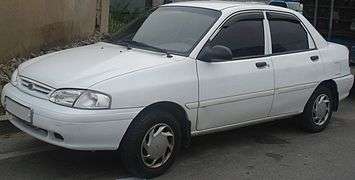
Pre-facelift Kia Avella Delta sedan (South Korea)
-
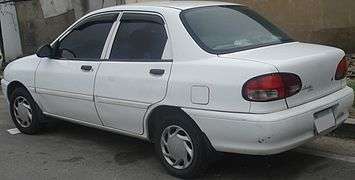
Pre-facelift Kia Avella Delta sedan (South Korea)
Third generation (1996–2002)
Sales of the second generation Festiva ended in 1996 for the Japanese market, being replaced by generation three—a badge engineered Mazda Demio (DW). Known as the "Ford Festiva Mini Wagon", the Japanese-only model range consisted of a single five-door hatchback body style available with either a 1.3 or 1.5 liter engine. Transmission options were a three-speed or four-speed automatic and a five-speed manual. Production continued until Mazda ceased manufacture of the equivalent Demio in 2002.
References
- 1 2 "Production History". Arab American Vehicles. Retrieved 2010-03-25.
- ↑ "Pars Khodro in history" (PDF). Pars Khodro. Retrieved 2010-09-13.
- ↑ "Iraq". Saipa Automotive Manufacturing Group. Archived from the original on 2012-03-27.
- ↑ "Plant Information". Ford Motor Company. Retrieved 2010-08-07.
- ↑ 日本フォード フェスティバ GT−A [Ford Festiva GT-A]. Goo-net (in Japanese). Proto Corporation. Retrieved 2011-02-15.
- 1 2 3 4 5 6 7 "Mazda 121 DB11 (Mk1) 121 1987–1989". GoAuto. John Mellor. Retrieved 2010-08-07.
- ↑ Halligan, Rod (May 2, 2009). "Mazda 121 – Carsguide Car of the Week". Carsguide. News Limited. Retrieved 2011-02-18.
- 1 2 3 4 Norman, Rich (2005). "History of Festiva". Fordfestiva.com. Retrieved 2010-08-07.
- ↑ Radley, Kevin (July 1986). "Far-Eastern Ford". Popular Science (New York City: Bonnier Corporation): 14.
- 1 2 3 "1991 Ford Festiva 5-dr hatch". GoAuto. John Mellor. Retrieved 2010-08-08.
- 1 2 3 4 5 6 7 "1990–1993 Ford Festiva: Full Review". HowStuffWorks. Archived from the original on 2009-06-01.
- 1 2 3 Hartford, Bill (June 1986). "Fordable Festiva". Popular Mechanics (Des Moines, Iowa: Hearst Magazines): 10.
- ↑ Vaughan, Brian (December 2, 2010). "1988 Ford Festiva Specifications". eHow. Retrieved 2011-02-20.
- ↑ Swan, Tony (September 1988). "Ford Festiva LX". Popular Mechanics (Des Moines, Iowa: Hearst Magazines): 121.
- ↑ Dammann, George (1993). 90 Years of Ford. Motorbooks International. p. 597.
After getting a slight facelift in 1990, the virtually unchanging Korean-built Festiva remained a carbon of last year.
- 1 2 3 Grant, Tina, ed. (1999). International directory of company histories, Volume 29. Detroit, Michigan: St. James Press. p. 65. ISBN 978-1-55862-388-0.
A major breakthrough for Kia occurred in 1987, however, when it started shipping automobiles to the largest single international car market, the United States. Kia reached and agreement to supply Ford with its Festiva model. [...] Kia planned to ship about 70,000 units annually for Ford and a like number of the cars to other countries. Kia's sales topped US $2.4 billion in 1987 as its work force swelled to about 23500. Kia's arrangement with Ford reflected its strategy, first evident in the mid-1980s, to gradually assume Japan's role as the leading supplier of low-end economy cars. By the mid-1980s, in fact, it was clear to Kia executives that Japan was reducing its emphasis on low-priced cars and focusing on higher-priced, high-profit vehicles. [...] Kia planned to use its low-cost production advantages to fill the void. Kia's greatest edge in comparison to US, European, and Japanese automakers was labor. Indeed, until the late 1980s Kia paid its workers a mere fraction of what their foreign counterparts earned. The savings were mirrored in cars like the Festiva, which enjoyed steady demand as a result of their extremely low prices. Over a period of about five years, Kia shipped 350,000 Festivas to Ford.
- ↑ "Mazda 121 (DA)". Red Book. Automotive Data Services. Retrieved 2011-02-20.
- 1 2 3 4 "Mazda 121 (DB11 (Mk1) 121) 1989–1991". GoAuto. John Mellor. Retrieved 2010-08-07.
- 1 2 "Ford Festiva (WA Festiva) 1991–1994". GoAuto. John Mellor. Retrieved 2010-08-07.
- ↑ "Ford Festiva 1991–2000". Marque Publishing Company. Retrieved 2010-08-07.
- ↑ "Ford Festiva WA". Red Book. Automotive Data Services. Retrieved 2010-08-08.
- ↑ Foulfellow, John. "KIA Pride (1991–2000 )". Honestjohn.co.uk. Retrieved 2010-08-07.
- 1 2 3 "Used Car Safety Ratings 2008" (PDF). Monash University. Retrieved 2011-05-22.
- 1 2 Mastrostefano, Raffaele, ed. (1990). Quattroruote: Tutte le Auto del Mondo 1990 (in Italian). Milan: Editoriale Domus. pp. 454–456.
- ↑ "Bubble and Squeak". Drive. Fairfax Media. 2000-02-04. Retrieved 2010-08-07.
- ↑ "1990~1999". Mazda. Retrieved 2010-08-07.
- 1 2 3 4 "Used Kia Pride (1991–2000) Car Review". Autoweb. Retrieved 2010-08-07.
- ↑ President Chávez to give first 300 Venirauto vehicles, ABN
- ↑ World of Cars 2006·2007. Warsaw: Media Connection Sp. z o.o. 2006. pp. 230–231.
- ↑ "Used Car Safety Ratings 2010" (PDF). Monash University. Retrieved 2011-05-22.
- ↑ "Kia Avella". Paul Trading Corp. Retrieved 2010-08-07.
- ↑ "Models of Kia Avella 1998". Paul Trading Corp. Retrieved 2010-08-07.
- 1 2 Limb, Jae-un (2010-10-06). "Blast From the Past #30: A small car that was big on safety". Korea JoongAng Daily. Retrieved 2011-06-27.
External links
![]() Media related to Ford Festiva at Wikimedia Commons
Media related to Ford Festiva at Wikimedia Commons
| « previous — Ford car timeline, United States & Canada, 1980–present | |||||||||||||||||||||||||||||||||||||
|---|---|---|---|---|---|---|---|---|---|---|---|---|---|---|---|---|---|---|---|---|---|---|---|---|---|---|---|---|---|---|---|---|---|---|---|---|---|
| Type | 1980s | 1990s | 2000s | 2010s | |||||||||||||||||||||||||||||||||
| 0 | 1 | 2 | 3 | 4 | 5 | 6 | 7 | 8 | 9 | 0 | 1 | 2 | 3 | 4 | 5 | 6 | 7 | 8 | 9 | 0 | 1 | 2 | 3 | 4 | 5 | 6 | 7 | 8 | 9 | 0 | 1 | 2 | 3 | 4 | 5 | 6 | |
| Subcompact | Fiesta | Festiva | Aspire | Fiesta | |||||||||||||||||||||||||||||||||
| Compact | Pinto | Escort | Escort | Escort | |||||||||||||||||||||||||||||||||
| Focus | Focus | Focus | |||||||||||||||||||||||||||||||||||
| Fairmont | Tempo | Tempo | Contour | ||||||||||||||||||||||||||||||||||
| Granada | |||||||||||||||||||||||||||||||||||||
| Mid-size | Granada | LTD | Fusion | Fusion | |||||||||||||||||||||||||||||||||
| Taurus | Taurus | Taurus | Taurus | ||||||||||||||||||||||||||||||||||
| Full-size | LTD | LTD Crown Victoria | Crown Victoria | Crown Victoria | |||||||||||||||||||||||||||||||||
| Country Squire | Five Hundred | Taurus | Taurus | ||||||||||||||||||||||||||||||||||
| Personal luxury | Thunderbird | Thunderbird | Thunderbird | Thunderbird | |||||||||||||||||||||||||||||||||
| Sport compact | EXP | EXP | Probe | Probe | Escort ZX2 | ZX2 | Fiesta ST | ||||||||||||||||||||||||||||||
| Focus ST | |||||||||||||||||||||||||||||||||||||
| Sports | Mustang | Mustang | Mustang | Mustang | |||||||||||||||||||||||||||||||||
| GT | |||||||||||||||||||||||||||||||||||||
| Kia Motors, a division of Hyundai Motor Group, automobile timeline, 1970s–present | |||||||||||||||||||||||||||||||||||||||||||||||
|---|---|---|---|---|---|---|---|---|---|---|---|---|---|---|---|---|---|---|---|---|---|---|---|---|---|---|---|---|---|---|---|---|---|---|---|---|---|---|---|---|---|---|---|---|---|---|---|
| Type | 1970s | 1980s | 1990s | 2000s | 2010s | ||||||||||||||||||||||||||||||||||||||||||
| 0 | 1 | 2 | 3 | 4 | 5 | 6 | 7 | 8 | 9 | 0 | 1 | 2 | 3 | 4 | 5 | 6 | 7 | 8 | 9 | 0 | 1 | 2 | 3 | 4 | 5 | 6 | 7 | 8 | 9 | 0 | 1 | 2 | 3 | 4 | 5 | 6 | 7 | 8 | 9 | 0 | 1 | 2 | 3 | 4 | 5 | 6 | |
| City car | Visto | Picanto | Picanto | ||||||||||||||||||||||||||||||||||||||||||||
| Ray | |||||||||||||||||||||||||||||||||||||||||||||||
| Subcompact car | Brisa | Pride | Qianlima | ||||||||||||||||||||||||||||||||||||||||||||
| Brisa II / K303 | Avella | Rio | Rio | Rio | |||||||||||||||||||||||||||||||||||||||||||
| Compact car | 124 | Capital | cee'd | cee'd | |||||||||||||||||||||||||||||||||||||||||||
| Sephia | Sephia | Cerato | Forte | Forte | |||||||||||||||||||||||||||||||||||||||||||
| Mid-size car | Concord | Credos | Optima | Optima | Optima | Optima | |||||||||||||||||||||||||||||||||||||||||
| Full-size car | 132 | Enterprise | Opirus | Cadenza | |||||||||||||||||||||||||||||||||||||||||||
| 604 | Potentia | Quoris | |||||||||||||||||||||||||||||||||||||||||||||
| Sports car | Elan | ||||||||||||||||||||||||||||||||||||||||||||||
| Compact SUV | Sportage | Sportage | Sportage | ||||||||||||||||||||||||||||||||||||||||||||
| Retona | |||||||||||||||||||||||||||||||||||||||||||||||
| Mid-size SUV | Sorento | Sorento | Sorento | ||||||||||||||||||||||||||||||||||||||||||||
| Mohave | |||||||||||||||||||||||||||||||||||||||||||||||
| Mini MPV | Venga | ||||||||||||||||||||||||||||||||||||||||||||||
| Compact MPV | Joice | Soul | Soul | ||||||||||||||||||||||||||||||||||||||||||||
| Carens | Carens | Carens | Carens | ||||||||||||||||||||||||||||||||||||||||||||
| Large MPV | Carnival | Carnival | Carnival | ||||||||||||||||||||||||||||||||||||||||||||
| Pickup truck | Bongo | Wide Bongo | Bongo Frontier | Bongo | |||||||||||||||||||||||||||||||||||||||||||
| Minivan | Besta | Pregio | |||||||||||||||||||||||||||||||||||||||||||||
| Bus | Combi | ||||||||||||||||||||||||||||||||||||||||||||||
| Granbird | Granbird | ||||||||||||||||||||||||||||||||||||||||||||||
| ||||||||||||||||||||||||||||||||||||||||||||||||||||||||||||||||||||||||||||||
| ||||||||||||||||||||||||||||||||||||